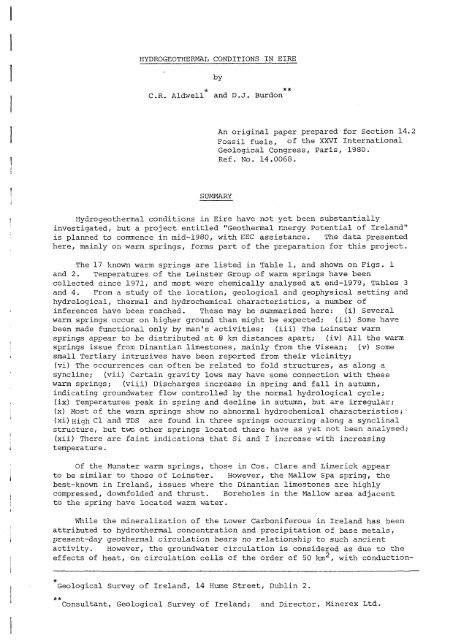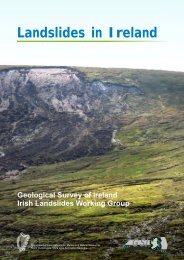Hydrogeothermal Conditions in Ãire - Geological Survey of Ireland
Hydrogeothermal Conditions in Ãire - Geological Survey of Ireland
Hydrogeothermal Conditions in Ãire - Geological Survey of Ireland
You also want an ePaper? Increase the reach of your titles
YUMPU automatically turns print PDFs into web optimized ePapers that Google loves.
HYDROGEOTHERMAL CONDITIONSIN EIREbyC.R. Aldwell* and D.J. Burdon**An orig<strong>in</strong>al paper prepared for section 14.2Fossil fuels, <strong>of</strong> the XXVI International<strong>Geological</strong> Congress, Paris, 1980.Ref. No. 14.0068.SUMMARY<strong>Hydrogeothermal</strong> conditions <strong>in</strong> Eire have not yet been substantially<strong>in</strong>vestigated, but a project entitled "Geothermal Energy Potential <strong>of</strong> <strong>Ireland</strong>"is planned to commence <strong>in</strong> mid-1980, with.EEC assistance. The data presentedhere, ma<strong>in</strong>ly on warm spr<strong>in</strong>gs, forms part <strong>of</strong> the preparation for this project.The 17 known warm spr<strong>in</strong>gs are listed <strong>in</strong> Table 1, and shown on Figs. 1and 2. Temperatures <strong>of</strong> the Le<strong>in</strong>ster Group <strong>of</strong> warm spr<strong>in</strong>gs have beencollected s<strong>in</strong>ce 1971, and most were chemically analysed at end-1979, Tables 3and 4. From a study <strong>of</strong> the location, geological and geophysical sett<strong>in</strong>g andhydrological, thermal and hydrochemical characteristics, a number <strong>of</strong><strong>in</strong>ferences have been reached. These may be summarised here: (i) Severalwarm spr<strong>in</strong>gs occur on higher ground than might be expected; (ii) Some havebeen made functional only by man's activities; (iii) The Le<strong>in</strong>ster warmspr<strong>in</strong>gs appear to be distributed at 8 krn distances apart; (iv) All the warmspr<strong>in</strong>gs issue from D<strong>in</strong>antian limestones, ma<strong>in</strong>ly from the Visean; (v) Somesmall Tertiary <strong>in</strong>trusives have been reported from their vic<strong>in</strong>ity;(vi) The occurrences can <strong>of</strong>ten be related to fold structures, as along asyncl<strong>in</strong>e; (vii) Certa<strong>in</strong> gravity lows may have some connection with thesewarm spr<strong>in</strong>gs; (viii) Discharges <strong>in</strong>crease <strong>in</strong> spr<strong>in</strong>g and fall <strong>in</strong> autumn,<strong>in</strong>dicat<strong>in</strong>g groundwater flow controlled by the normal hydrological cycle;(ix) Temperatures peak <strong>in</strong> spr<strong>in</strong>g and decl<strong>in</strong>e <strong>in</strong> autumn, but are irregular;(x) Most <strong>of</strong> the warm spr<strong>in</strong>gs show no abnormal hydrochemical characteristics;·(xi) High Cl and TDS are found <strong>in</strong> three spr<strong>in</strong>gs occurr<strong>in</strong>g along a syncl<strong>in</strong>alstructure, but two other spr<strong>in</strong>gs located there have as yet not been analysed;(xii) There are fa<strong>in</strong>t <strong>in</strong>dications that Si and I <strong>in</strong>crease with <strong>in</strong>creas<strong>in</strong>gtemperature.Of the Munster warm spr<strong>in</strong>gs, those <strong>in</strong> Cos. Clare and Limerick appearto be similar to those <strong>of</strong> Le<strong>in</strong>ster. However, the Mallow Spa spr<strong>in</strong>g, thebest-known <strong>in</strong> <strong>Ireland</strong>, issues where the D<strong>in</strong>antian limestones are highlycompressed, downfolded and thrust. Boreholes <strong>in</strong> the Mallow area adjacentto the spr<strong>in</strong>g have located warm water.While the m<strong>in</strong>eralization <strong>of</strong> the Lower Carboniferous <strong>in</strong> <strong>Ireland</strong> has beenattributed to hydrothermal concentration and precipitation <strong>of</strong> base metals,present-day geothermal circulation bears no relationship to such ancientactivity. However, the groundwater circulation is considered as due to theeffects <strong>of</strong> heat, on cirCUlation cells <strong>of</strong> the order <strong>of</strong> 50 km 2 , with conduction-* <strong>Geological</strong> <strong>Survey</strong> <strong>of</strong> <strong>Ireland</strong>, 14 Hume Street, Dubl<strong>in</strong> 2.** Consultant, <strong>Geological</strong> <strong>Survey</strong> <strong>of</strong> <strong>Ireland</strong>; and Director, M<strong>in</strong>erex Ltd.
















